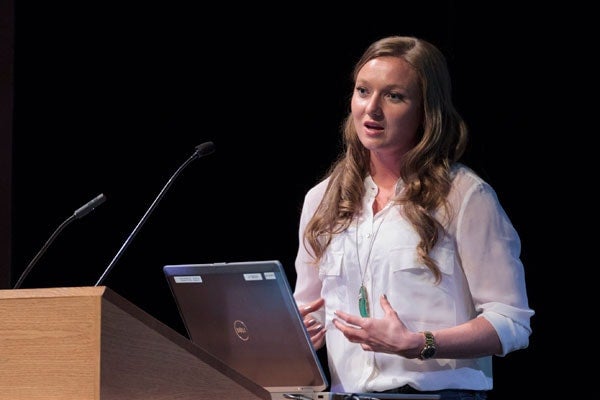
Olympian Rosie McLennan talks brain and body symbiosis at U of T
Published: May 13, 2013
The perfect coordination of mind and body is easy to take for granted. But it can mean the difference between safety and danger, success and failure – or silver and gold.
"The challenge for any athlete, regardless of the sport, is finding that balance between letting your body learn these patterns, trusting your body to execute the movements, while keeping conscious control,” said Olympic gold medalist and U of T alumna Rosie McLennan.
McLennan spoke at a May 8 symposium, “The Heights of Human Performance: The Symbiosis of Brain and Body,” the fifth public symposium hosted by the Faculty of Kinesiology & Physical Education.
The event hosted discussion on a spectrum of motor control theory applications from the everyday to the extraordinary. Experts shared reflections on how the complex synergy between brain and body means that to achieve true excellence in various movement-dependent fields, it takes more than repetition by rote.
McLennan admitted that errors often occur when mind-body habits take over in explaining how she learned and successfully executed the trampoline flips and twists required to earn top spot at last summer’s Olympic Games in London.
Professor Luc Tremblay followed MacLennan’s talk, discussing how interpretation of visual information influences the execution of all movement. He cited simple examples, such as picking up a cup of coffee, and elaborate tasks, such as landing a double tuck somersault, which interestingly his research found was performed best when vision was slightly limited. “The use of sensory information during movement is quite sophisticated,” he told the audience of over 200. “It can be misused or optimized, and there's not always the need to even process it.”
Professor Tim Welsh, coordinator of the Centre for Motor Control, hosted evening and followed Tremblay’s presentation with a more hypothetical talk entitled, “Me, Myself and Virtual I.” Welsh explored how the overarching principles addressed by his fellow speakers are informing the design of new, more sophisticated human-computer interfaces. He also outlined how various developments in gaming research can be applied to optimize training in various fields, from rehab sciences to flight simulations.
Dr. Heather Carnahan then wove the evening’s brain-body themes together in the context of the operating room and the medical field. Carnahan referenced instances when robots and simulated environments were optimal, but emphasized that there are still many cases when the precision and elegance of the symbiosis between the human brain and body are unrivaled. She elaborated on the role of simulations in medical training.
“Simulations allow us to make errors and that is important in the learning process, and no one gets hurt,” said Carnahan.
Globe and Mail science reporter Ivan Semeniuk moderated the panel and audience questions about the balance between relying on engrained mind-body patterns and remaining mentally spry.
Carnahan explained what differentiates excellence in her field of experts, who after 100,000 hours of training can easily slip into movement my memory.
"When something goes wrong in the operating room, the good surgeons slow down; they turn the music off and they pay a lot of attention to what's happening," she said. "The less experienced do not—and that’s when mistakes happen."
Photos from the evening are available in this online gallery.
Valerie Iancovich writes for the Faculty of Kinesiology & Physical Education.



